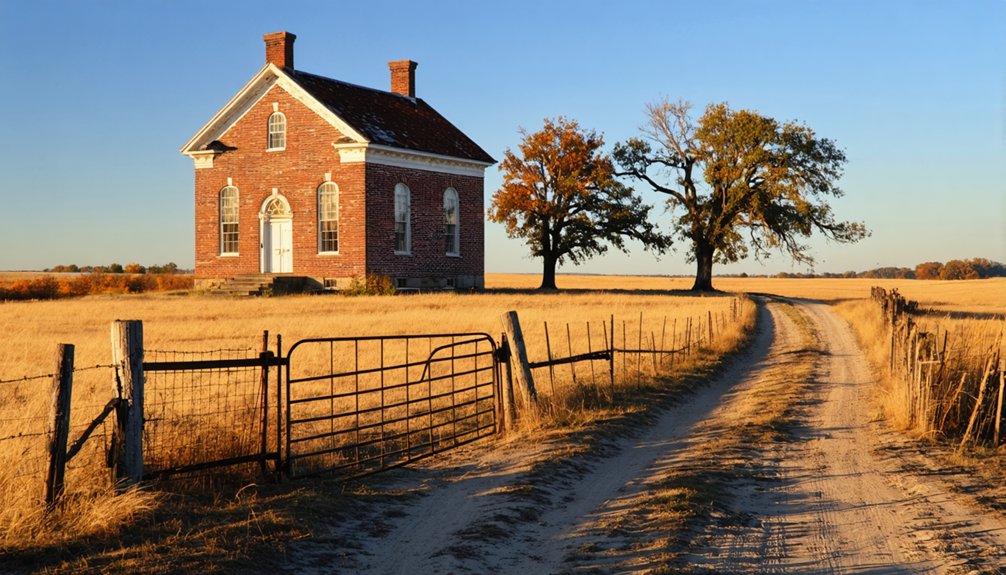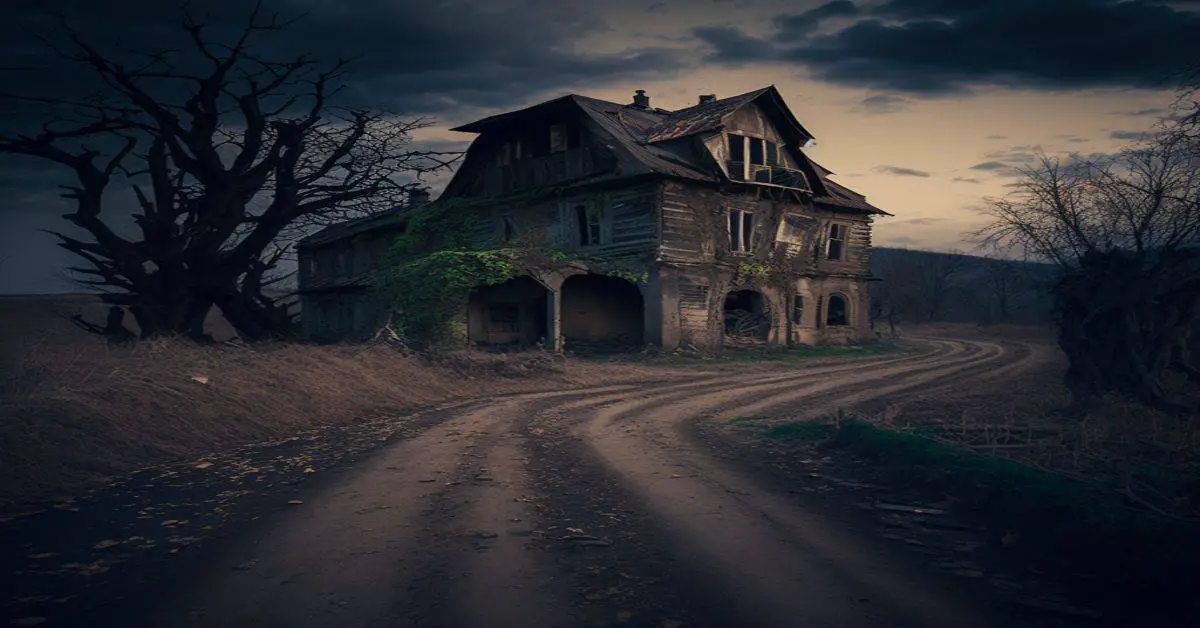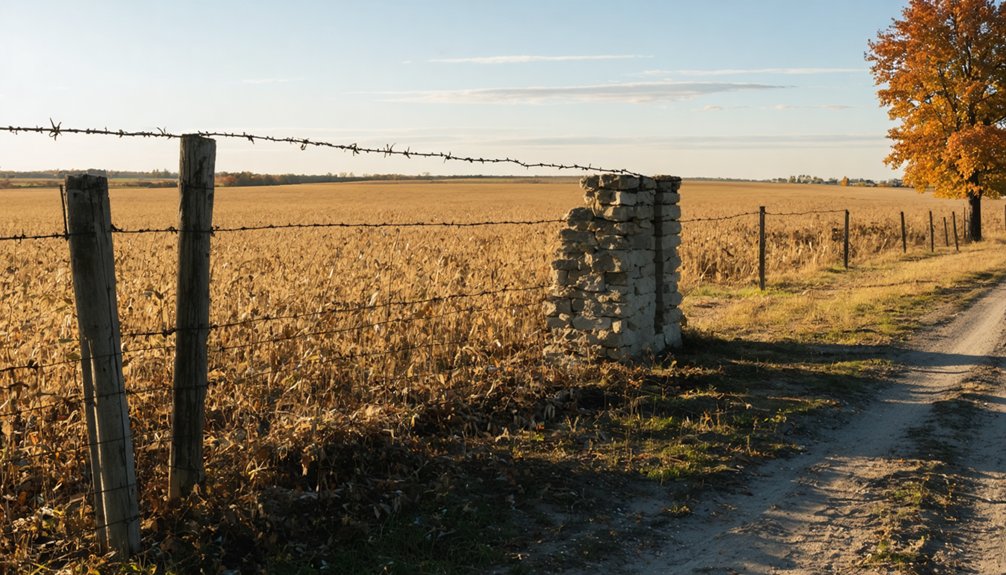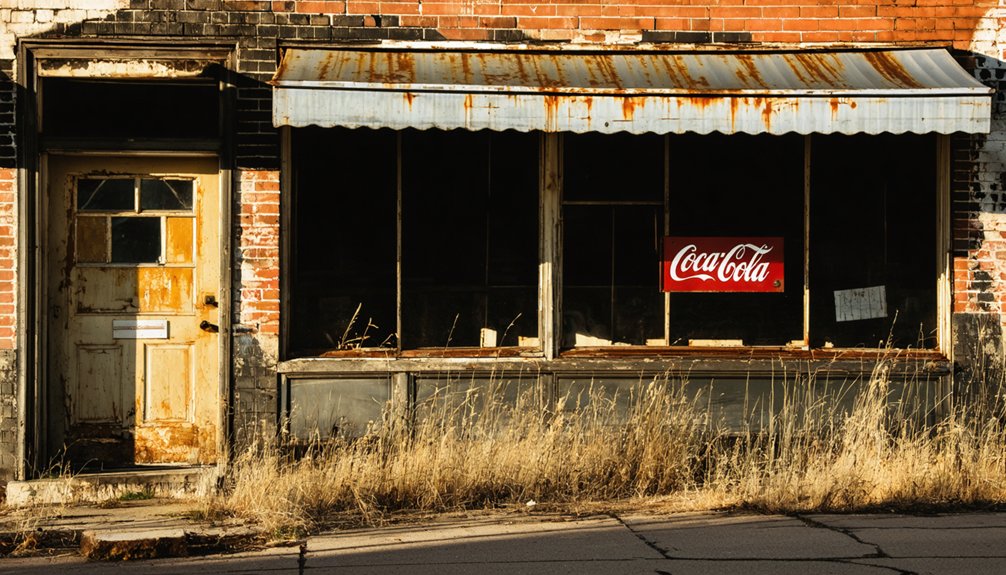You’ll find Benjaminville’s ghost town remnants in McLean County, Illinois, where three Quaker families established a thriving settlement in 1856. While the community initially prospered through wheat farming and trade, its fate changed dramatically when the Lake Erie & Western Railroad bypassed it by 1.5 miles in the late 1860s. Today, only the 1859 Meeting House and its historic cemetery remain, telling a compelling story of religious freedom, prairie life, and how a mere mile-and-a-half distance transformed a bustling town’s destiny.
Key Takeaways
- Benjaminville was founded in 1856 by three Quaker families and thrived as a farming community until railroad development bypassed it.
- The Lake Erie & Western Railroad’s 1.5-mile bypass in the late 1860s triggered the settlement’s economic decline and eventual abandonment.
- By 1874, most homes and businesses were abandoned, with residents relocating to nearby towns with better railroad access.
- Only the Benjaminville Friends Meeting House and historic cemetery remain as physical remnants of the former settlement.
- The Meeting House, listed on National Register in 1984, stands as testament to the ghost town’s Quaker heritage.
A Quaker Vision Takes Root (1856)
When three determined Quaker families – the Marots, Clements, and Benjamins – arrived in McLean County, Illinois in 1856, they established what would become the settlement of Benjaminville on a raised stretch of fertile prairie.
You’ll find their choice of location wasn’t random – they’d sought land perfectly suited for wheat cultivation and communal farming.
As part of the broader Quaker migration westward, these pioneers envisioned more than just farmland – they dreamed of creating a spiritual haven where their agricultural practices could flourish alongside their faith.
The settlement aligned with the expansion of Quaker monthly meetings across central Illinois, making Benjaminville a beacon for others seeking both religious freedom and rich soil.
Their timing couldn’t have been better, as the mid-1850s marked a period of significant Quaker growth throughout the region.
The town’s initial prosperity was built on its rich fertile soil, which attracted more settlers to join the original founding families.
By 1859, the community had constructed their first meeting house for $1,000, establishing a central gathering place for worship and community events.
The Founding Families and Their Legacy
Although Joseph Marot, Isaac Clement, and Timothy Benjamin laid Benjaminville’s foundation, it was George W. Brown who emerged as a prominent leader in the Society of Friends.
While others established Benjaminville’s roots, George W. Brown rose to become the guiding force among the Friends.
These founding families were drawn to the area’s fertile soil, establishing a tight-knit Quaker community that would shape local development for generations.
Their community legacy lives on through:
- The Benjaminville Friends Meeting House, constructed in 1859, which stands as the last remaining monument to their presence
- The historic burial ground, where you’ll find the final resting places of these pioneering families
- The preservation of their agricultural heritage, as the surrounding land continues to be farmed just as these founding families once did
You can still feel their influence today, though the railroad’s absence ultimately led to the settlement’s decline.
Life in a Prairie Settlement
Life in Benjaminville demanded extraordinary physical and mental fortitude from its prairie settlers. You’d find yourself laboring from dawn to dusk, working the land with horses and oxen, or practicing essential trades like blacksmithing and millinery that kept the community functioning.
Settler resilience showed in their ability to produce cash crops while maintaining self-sufficiency through trading and crafting daily necessities. Women often turned to growing flower gardens as a therapeutic way to combat the mental strain of frontier life. Like the settlers at Railroad Town, inhabitants relied on wooden boardwalks to navigate the muddy streets during wet seasons.
The isolation struggles were particularly harsh on women who’d spend weeks alone managing homesteads while their husbands traveled for business. You might’ve found relief from “prairie fever” at community gatherings or church meetings, but these social outlets were scarce.
The town’s infrastructure – its general store, blacksmith shop, and bank with reinforced walls – served as both economic lifelines and social anchors in this challenging frontier environment.
The Meeting House: Heart of the Community
You’ll find the Benjaminville Meeting House’s interior reflects traditional Quaker simplicity, with its open prayer room design allowing worshippers to face each other in a square arrangement that fostered equality and community.
The 1874 structure’s plain wooden benches and unadorned walls emphasized the Friends’ focus on direct spiritual connection rather than ornate religious symbols.
As Benjaminville’s spiritual center for over a century, the meeting house evolved from a purely religious space into a vibrant gathering place where Quakers tackled social issues like women’s suffrage and Native American affairs.
Unique Prayer Room Design
What made the Benjaminville Friends Meeting House unique among 19th-century Quaker prayer spaces was its revolutionary single-room worship design.
You’d find men and women worshiping together in one space, breaking from traditional Quaker customs that insisted on gender separation. This distinctive architecture embodied the community’s progressive views on communal equality.
The prayer room’s thoughtful design incorporated three key elements:
- An open floor plan that encouraged equal participation from all members
- Simple, unadorned walls free of religious symbols to maintain focus on spiritual reflection
- Original materials and layout preserved since 1874, offering you an authentic glimpse into Quaker worship practices
This innovative approach to sacred space design reflected Benjaminville’s commitment to simplicity and inclusivity, setting it apart from its contemporaries. Like the LEED Gold certified First Unitarian Society of Madison, the building prioritized environmental consciousness in its construction.
The well-constructed example of Quaker meeting house architecture still stands as the only remaining structure from the original village of Benjaminville.
Religious Gathering Space Evolution
Since its establishment in 1859, the Benjaminville Friends Meeting House emerged as the spiritual and social nucleus of this Illinois Quaker settlement.
You’ll find that this $1,000 initial structure, replaced in 1874, became far more than a place of worship – it transformed into a vibrant hub of community engagement and social activism.
At the meeting house, you’d have witnessed passionate discussions on peace advocacy, women’s suffrage, and Native American affairs.
As one of Illinois’ strongest Quaker settlements by 1879, the space hosted statewide Friends gatherings and served as a catalyst for regional reform movements.
The meeting house’s enduring legacy is reflected in its National Register listing in 1984, recognizing its historical significance to the region.
The interior features pine wainscotting that adds to its architectural character and historical authenticity.
Even as Benjaminville’s other buildings vanished after being bypassed by the Lake Erie Railroad, the meeting house stood firm, preserving its role in fostering moral campaigns and civic dialogue.
Railroad Politics and Economic Impact
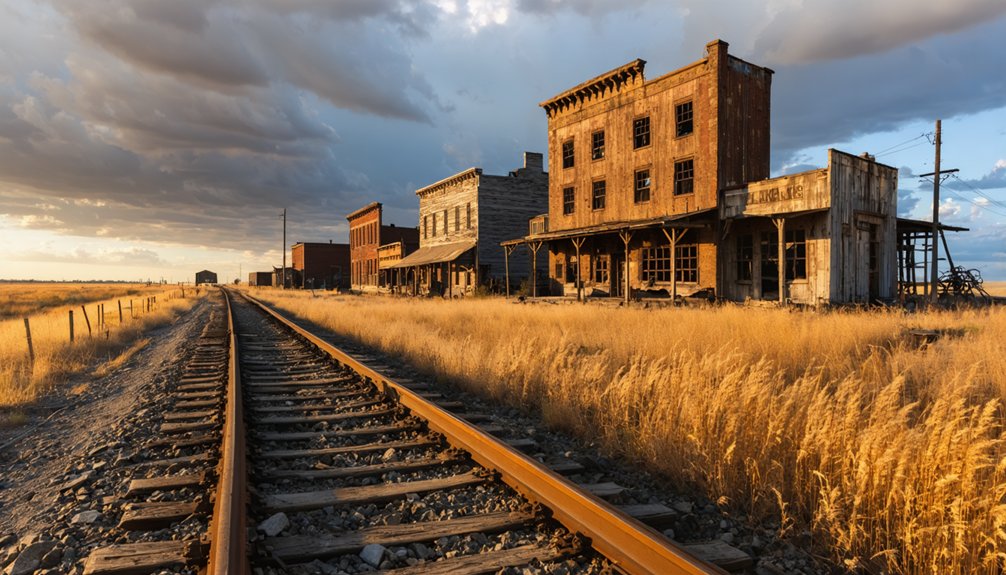
When the Lake Erie & Western Railroad chose to bypass Benjaminville by 1.5 miles in the late 1860s due to the town’s higher elevation, you’d have witnessed the beginning of the community’s economic isolation.
You can trace how this single routing decision triggered a cascade of business closures and population decline throughout the 1870s, as the town lost critical market access that neighboring rail-connected communities enjoyed.
By 1874, the town was almost completely deserted, with only the Meeting House remaining as a silent witness to the once-thriving Quaker community.
Similar to the era when steam power growth fueled Illinois’ development after 1818, the railroad’s political influence proved insurmountable for Benjaminville’s Quaker residents, who couldn’t persuade the company to alter its preferred route despite their settlement’s social prominence in Illinois.
Rail Route Decision Impact
The Lake Erie & Western Railroad‘s decision to route its tracks 1.5 miles south of Benjaminville proved catastrophic for the small Quaker settlement’s future.
Railroad efficiency and economic priorities trumped local community needs, as the company sought easier grades and lower construction costs rather than serving pre-existing settlements.
You’ll find that this strategic routing decision led to three devastating consequences:
- Local businesses began closing around 1870 as commerce shifted to rail-connected towns.
- Churches relocated closer to railroad access points, fragmenting the community.
- Agricultural opportunities became severely limited without direct rail access.
The railroad’s autonomous authority to prioritize profitable routes meant Benjaminville’s Society of Friends couldn’t influence the decision, despite their political activity.
This bypass ultimately left the meeting house as the sole survivor of what was once a thriving settlement.
Economic Isolation Effects
Bypassing Benjaminville created a domino effect of economic hardships that rippled through the community well into the 1870s.
When the Lake Erie & Western Railroad chose alternate routes, you’d have witnessed the town’s rapid economic decline as it lost access to crucial trade networks and commercial opportunities.
Without rail connections, farmers couldn’t efficiently transport their crops to market, and merchants struggled to stock their shelves at competitive prices.
The resulting community disintegration became evident as families relocated to railroad-connected towns nearby.
Your business prospects would’ve dimmed as investment dried up and commercial growth stalled.
While neighboring communities flourished with their rail links, Benjaminville’s isolation forced an exodus of residents and businesses, leaving only the Friends Meeting House and cemetery as evidence of what once was.
Transportation Network Shifts
Despite having petitioned vigorously for rail service, Benjaminville’s hopes were dashed as Lake Erie & Western Railroad surveyors chose an alternative route 1.5 miles south of town. This transportation evolution reflected harsh business realities, as railroad companies prioritized cost-efficient routes with minimal elevation changes between major hubs like Bloomington and Peoria.
The impact on Benjaminville was swift and devastating:
- Businesses relocated closer to the rail network, abandoning their original locations.
- Access to regional markets became severely restricted, crippling local commerce.
- The town’s population declined rapidly as the rail bypass effectively isolated the community.
The expanding regional rail network transformed Illinois’s economic landscape, favoring communities with direct rail connections while leaving bypassed towns like Benjaminville to fade into obscurity.
The Town’s Gradual Disappearance
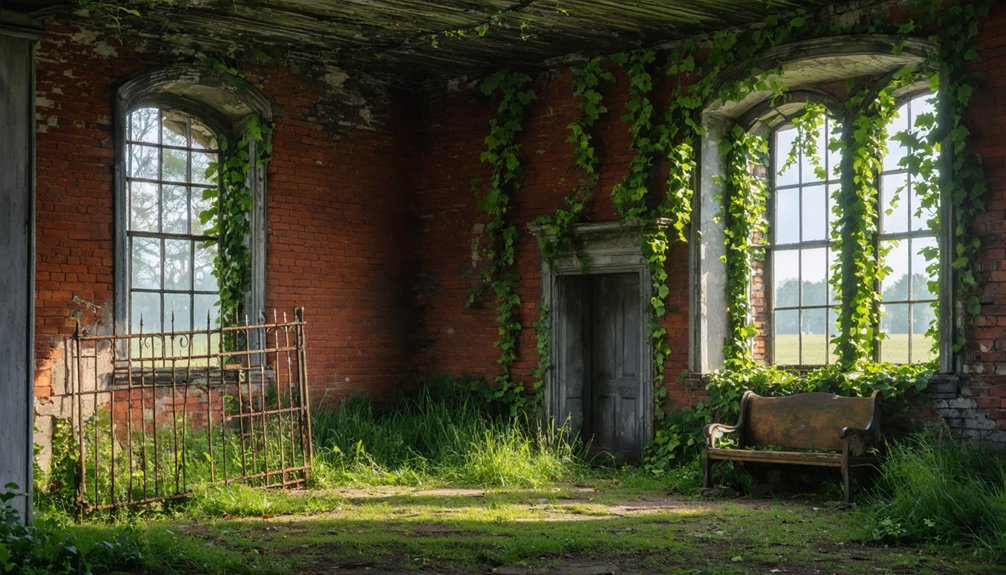
Once Lake Erie & Western Railroad chose a route 1.5 miles south of Benjaminville in 1870, the town’s fate was sealed.
You’d have witnessed the rapid unraveling of a once-thriving Quaker settlement as residents began relocating to areas with rail service, particularly Gibson City and Bloomington.
The strong community spirit that had defined Benjaminville since 1856 couldn’t overcome the harsh reality of agricultural decline.
Without rail access to transport their produce to market, farmers found it increasingly difficult to sustain their livelihoods.
By 1874, homes and businesses were dismantled or abandoned, leaving only the Quaker Meeting House standing as a silent sentinel.
The surrounding prairie land, once dotted with bustling farms and communal buildings, reverted to open fields, effectively erasing most traces of this former settlement.
Sacred Ground: The Historic Cemetery
While most of Benjaminville faded into memory, the town’s historic cemetery endures as a poignant tribute to its Quaker heritage.
You’ll find this sacred ground adjacent to the 1859 Friends Meeting House, where simple gravestones reflect the Quakers’ commitment to plainness and humility.
The cemetery’s preservation efforts highlight three distinct features:
- Traditional gender and age-segregated burial arrangements
- Unadorned markers that contrast with ornate Victorian-era graves of neighboring communities
- Historical records of founding families that shaped McLean County’s early development
Today, you can walk these peaceful grounds, where cemetery preservation maintains the site’s historic integrity.
The burial ground stands as one of the last physical connections to Benjaminville’s pioneering spirit and steadfast Quaker customs that once defined this prairie settlement.
Architectural Heritage and Preservation
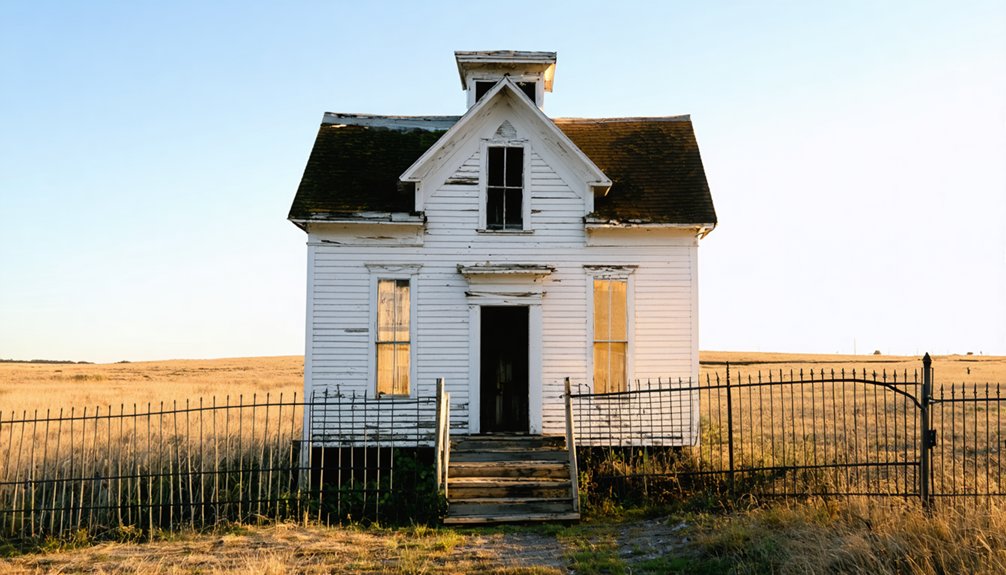
Standing as the last physical remnant of Benjaminville’s original structures, the 1874 Friends Meeting House embodies the quintessential Quaker architectural style that dominated colonial America through the 19th century.
You’ll find its architectural significance in the simplicity and functionality that characterizes Quaker design principles, unchanged for generations.
While other buildings, including the old wagon shop, have succumbed to time, preservation efforts have focused on maintaining this historic meetinghouse.
In 1983, the building and its burial ground earned their place on the National Register of Historic Places, cementing their importance in McLean County’s heritage.
Today, nature has reclaimed much of the surrounding area, creating a serene backdrop for this enduring symbol of Quaker settlement in Illinois.
Exploring the Ghost Town Today
Today, visitors to Benjaminville Ghost Town will find themselves on flat, raised prairie land about 8 miles east of Bloomington, Illinois.
The once-thriving Quaker community has surrendered to nature, with only the 1859 Meeting House standing as evidence to the former settlement’s existence.
You’ll discover a hauntingly beautiful landscape where community dynamics have shifted from bustling town life to quiet solitude.
For your visit, remember these essential experiences:
- Explore the preserved Meeting House, now listed on the National Register of Historic Places
- Photograph the weathered architecture against the expansive prairie backdrop
- Walk the grounds where some visitors report ghostly encounters near the burial ground
The site’s remote location requires preparation, but you’ll find the historic atmosphere worth the journey.
Echoes of the Past: Cultural Significance
When you explore the abandoned site of Benjaminville today, you’ll find traces of the Quakers’ commitment to religious freedom and community-centered design in the Meeting House’s strategic placement at the heart of what was once a thriving settlement.
The Quaker principles of simplicity and equality shaped the town’s layout, with homes and businesses arranged to foster connection among its members rather than social hierarchy.
Your visit reveals how the fateful decision of the Lake Erie & Western Railroad to bypass Benjaminville by 1.5 miles ultimately severed the community’s lifeline, leading to its transformation from a vibrant religious haven to a ghost town by 1874.
Religious Freedom’s Prairie Legacy
As pioneers sought religious freedom on the Illinois prairie, Benjaminville emerged in 1856 as a reflection of Quaker values and social reform.
You’ll find that this tight-knit community became a beacon of progressive ideals, where residents actively championed peace, equality, and justice. The 1874 Meeting House served as the heart of their community activism, hosting gatherings that shaped the region’s social conscience.
- The settlement’s commitment to women’s suffrage challenged prevailing societal norms
- Their steadfast opposition to gambling and boxing reflected deep-rooted Quaker values
- The community’s emphasis on peaceful resolution and social justice created lasting regional impact
While the town’s physical presence has largely vanished, Benjaminville’s legacy of religious freedom and social reform continues to resonate through its preserved Meeting House, now listed on the National Register of Historic Places.
Quaker Community Design Principles
The architectural legacy of Benjaminville’s Quaker settlement remains powerfully evident in its 1874 Meeting House, which stands as a tribute to their distinct community design principles.
You’ll find this simple, rectangular wood-frame structure embodies core Quaker values of plainness and equality, with its unadorned design and practical interior where wooden benches face each other for communal worship.
The Meeting House served as the heart of Benjaminville’s intentional community, surrounded by modest graves that reflect their egalitarian beliefs.
You can trace how the settlement’s layout prioritized spiritual connection and social justice, with the building doubling as a hub for reform movements.
The preserved structure, now on the National Register of Historic Places, demonstrates how Quaker architecture seamlessly merged religious conviction with communal values.
Transportation’s Impact on Heritage
Despite initial promises of rail connectivity, Benjaminville’s fate changed dramatically when the Lake Erie & Western Railroad diverted its route 1.5 miles south of the settlement in the 1870s.
The transportation evolution proved devastating for this once-thriving Quaker community, as the lack of direct rail access severed crucial economic lifelines and accelerated its decline.
You’ll find evidence of community resilience in three lasting impacts:
- The Friends Meeting House stands as the sole survivor, preserving Quaker architectural heritage since 1874.
- The carefully maintained burial ground continues to tell stories of social and religious distinctions.
- The transformation from bustling town to farmland reflects broader Midwestern settlement patterns.
Today, you’re witnessing a landscape where transportation decisions of the past have permanently altered the cultural fabric of a once-vibrant community.
Frequently Asked Questions
Were There Any Notable Conflicts Between Quakers and Non-Quakers in Benjaminville?
You’ll find no documented Quaker tensions or Non-Quaker interactions that suggest conflict in the settlement. Their peaceful coexistence is evident, with burial ground separation being the only notable distinction between groups.
What Crops Did the Benjaminville Farmers Primarily Grow in the Prairie Soil?
With soil productivity reaching 140-143 out of 147, you’d find wheat as your main crop, followed by corn. You’d use crop rotation and traditional farming techniques to maximize the rich prairie soil.
How Did Mail Service Operate in Benjaminville Before and After Its Decline?
You’d receive mail via horse-drawn wagons on established mail routes before the town’s decline. After, you’d rely on nearby towns’ post offices as rail transport replaced local delivery methods.
Did Any Famous Historical Figures Ever Visit or Stay in Benjaminville?
You won’t find any famous visitors in the town’s history. While Benjaminville held historical significance as a Quaker settlement, its brief existence and remote location kept it isolated from notable historical figures.
What Happened to the Town’s Original Buildings and Where Were They Relocated?
A million stories were lost as buildings weren’t actually relocated – they gradually vanished through abandonment after the railroad bypassed the town. Only the Friends Meeting House survives, preserved in its original location.
References
- https://www.frrandp.com/2020/12/benjaminville-illinois.html
- https://drloihjournal.blogspot.com/2019/10/lost-towns-of-illinois-village-of-benjaminville-illinois.html
- https://storymaps.arcgis.com/stories/043201d4267e4a66b44e7922832df7a2
- https://www.freakyfoottours.com/us/illinois/
- https://kids.kiddle.co/Benjaminville
- https://evendo.com/locations/illinois/central-illinois/landmark/benjaminville-historic-site
- https://www.hmdb.org/m.asp?m=157153
- https://en.wikipedia.org/wiki/Benjaminville_Friends_Meeting_House_and_Burial_Ground
- https://www.youtube.com/watch?v=93k0qtvzkn4
- https://ilym.org/ilym/wp-content/uploads/2018/11/History-of-Illinois-Yearly-Meeting_0.pdf
